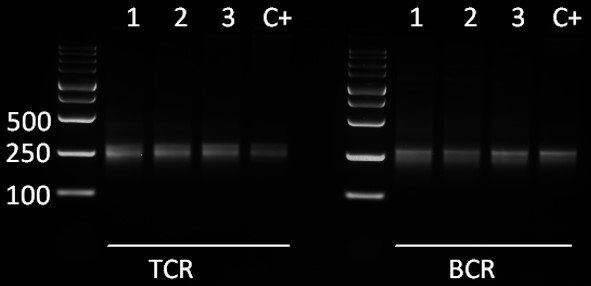In this step, the yield of products from the Index Primer PCR Reaction—the Amplified Indexed Libraries of transcripts from each sample—are measured and then pooled in equimolar amounts for sequencing.
Quantify the Amplified Indexed Libraries
- Analyze the Amplified Indexed Libraries using one of the following methods:
- Standard Method: Separate 5 μl of Amplified Indexed Libraries on a 3% agarose-TAE gel and analyze the size distribution of NGS probes by UV transilluminator. See below for the expected results of amplified libraries generated from good-quality PBMC DNA samples. For both AIR TCR and AIR BCR assay the smear with several bright bands should be in the 200-300 bp range.
- Alternative Method: Analyze 1 µl of each of the Amplified Indexed Libraries on either an Agilent Bioanalyzer with the Agilent High Sensitivity DNA Kit (Cat.# 5067-4626) or Fragment Analyzer using the High Sensitivity NGS Analysis Kit (Cat.# DNF-473-1000) using the manufacturer’s protocol.

- Analyze yields of the Amplified Indexed Libraries. The yield should all be roughly the same for all experimental samples within +/- 2-3-fold levels and should be similar to Positive Control PBMC DNA sample. A negative control sample should not generate any significant yield of amplified products. If some samples show significantly lower yield (e.g., >5-10-fold) of amplification products, it could be an indication of differences in the amount, quality of DNA or content of lymphocyte DNA used in AIR assay. For experimental DNA samples with significantly less yield of PCR products than other samples or the Positive Control DNA sample (i.e., >5-10-fold difference), you can rerun the Amplified Indexed Libraries in the thermal cycler (see Note below) for 2-5 additional cycles. After cycling, quantify the products again relative to the Positive Control DNA. Note: Do not include the Positive Control DNA sample in additional cycles. Remove the positive control sample from the plate and keep it as a reference to assess the quantity of your PCR samples.
Remove Excess PCR Primers and Combine Samples
- Remove excess primers from the completed PCR reactions by adding 1 µl of Primer Removal Enzyme to each of the Amplified Indexed Libraries and the Negative Control sample, then incubate at 37°C for 30 minutes.
- To ensure accurate quantification for sequencing, you need to quantitate the yield of the Amplified Indexed Libraries. The preferred method is to analyze 2 µl of each of the Amplified Indexed Libraries using either an Agilent Bioanalyzer with the Agilent High Sensitivity DNA Kit (Cat.# 5067-4626) or Fragment Analyzer using the High Sensitivity NGS Analysis Kit (Cat.# DNF-473-1000) using the manufacturer’s protocol. Quantifying the PCR products after the removal of PCR primers is more accurate than quantifying before the primer removal clean up step.

- After primer removal and quantification, use the yield assessment of the Amplified Indexed Libraries as a basis to combine equimolar amounts of each of the Amplified Index Libraries into a single pool for NGS. For example, if the yield of Library 1 is twice that of Library 2, then mix 5 µl of Library 1 with 10 µl of Library 2. To minimize sample-to-sample sequencing variations, combine and load all experimental samples onto one NGS flow cell.
For the DriverMap AIR Assay, which generates a complex pool of amplified TCR or BCR CDR3 regions (40K-100K from 5 µg of PBMC DNA), refer to the table below for guidelines on how many samples may be combined for different instruments and read depths. Generally, you should aim for 5-10 million reads per AIR sample (starting from 5 µg of PBMC DNA) or achieve at least an average of 20 reads per DNA molecule. For Illumina instruments, AIR profiling assays require the use of 300-n paired-end reagent kits.
| Instrument | Reads per flow cell | Number of samples for multiplexing per flow cell | Reads per AIR sample |
|---|---|---|---|
| NextSeq 500/550 | 120 million (medium throughput) | 12-20 | 6-10M reads/sample |
| NextSeq 500/550 | 400 million (high throughput) | 40-72 | 6-10M reads/sample |
| NextSeq 2000 | 100 million (P2 flow cell) | 10-12 | 10M reads/sample |
| NextSeq 2000 | 400 million (P2 flow cell) | 40 | 10M reads/sample |
| NextSeq 2000 | 1200 million (P3 flow cell) | 96 | 10M reads/sample |
| NovaSeq Series | 6000 million (S2) | 500 | 10M reads/sample |
Need more help with this?
Contact Us

